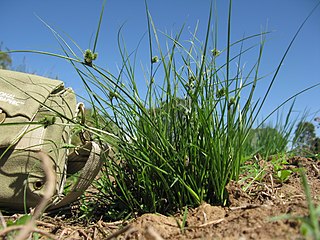
The Cyperaceae are a family of graminoid (grass-like), monocotyledonous flowering plants known as sedges. The family is large, with some 5,500 known species described in about 90 genera, the largest being the "true sedges" genus Carex with over 2,000 species.

Triodia is a large genus of hummock grass endemic to Australia. The species of this genus are known by the common name spinifex, although they are not a part of the coastal genus Spinifex. Many soft-leaved Triodia species were formerly included in the genus Plectrachne. Triodia is known as tjanpi (grass) in central Australia, and have several traditional uses amongst the Aboriginal Australian peoples of the region.

Lepidosperma is a genus of flowering plant of the family Cyperaceae. Most of the species are endemic to Australia, with others native to southern China, southeast Asia, New Guinea, New Caledonia and New Zealand.

Gahnia is a genus of sedges native to China, Southeast Asia, New Guinea, Australia, New Zealand and a number of Pacific Islands. The common name is due to the toothed margins. It often forms tussocks.

Gahnia filum, the chaffy saw-sedge, is a tussock-forming perennial in the family Cyperaceae, endemic to Australia. It grows to between 60 and 110 cm in height.

Chamaescilla is a genus of Australian herbs in the subfamily Hemerocallidoideae within the asphodel family. They have grass-like basal leaves and tuberous roots. The flowers have six petals and six stamens. The seed capsules contain black, glossy seeds.

Gahnia trifida, the coastal saw-sedge, is a tussock-forming perennial in the family Cyperaceae, endemic to southern Australia.

Chamaescilla corymbosa, commonly known as blue stars, blue squill or mudrurt, is a tuberous perennial herb species in the genus Chamaescilla. It is endemic to southern Australia.

Hesperilla chrysotricha, also known as the chrysotricha skipper or goldenhaired sedge-skipper, is a species of butterfly in the family Hesperiidae. It is found in the Australian states of Victoria, Tasmania, South Australia and Western Australia.

Hesperilla donnysa, also known as the donnysa skipper or varied sedge skipper, is a species of butterfly in the family Hesperiidae. It is found in the Australian Capital Territory, New South Wales, Queensland, South Australia, Tasmania, Victoria and Western Australia.

Hesperilla idothea, commonly known as the flame sedge-skipper, is a species of butterfly in the family Hesperiidae. It is found in the Australian states of New South Wales, Queensland, South Australia and Victoria.

Gahnia aspera known as the rough saw-sedge or round sawsedge is a tussock forming perennial plant, often seen in moist situations. The long strap like leaves grow to 80 cm long.

Gahnia grandis is a tussock-forming perennial plant found in southeastern mainland Australia and Tasmania.

Schoenus is a predominately austral genus of sedges, commonly known as bogrushes, or veldrushes in South Africa. Species of this genus occur mainly in South Africa, Australia and Southeast Asia. Others are found in scattered locations worldwide, from Europe to Asia, North Africa and the Americas. Three species occur in the peatlands of southern South America, including S. antarcticus which is found in Tierra del Fuego, where it forms a component of hyperhumid Magellanic moorland.

Gahnia sieberiana, commonly known as the red-fruit saw-sedge, is a tussock-forming perennial plant in the family Cyperaceae, endemic to Australia. It is a widespread plant that favours damp sunny sites. Many insect larvae have been recorded feeding on the red-fruit saw-sedge. It may grow over 2 metres tall.

Machaerina juncea, commonly known as bare twig-rush or tussock swamp twig rush, is a sedge in the sedge family, Cyperaceae, that is native to Australia, New Zealand, and New Caledonia.

Carex inversa, commonly known as knob sedge, is a species of sedge of the family Cyperaceae that is native to parts of Australia and New Zealand and has also been introduced into Great Britain.

Cyperus vaginatus, commonly known as stiff-leaf sedge or stiff flat-sedge, is a sedge of the family Cyperaceae that is native to Australia.
Gahnia ancistrophylla, also known as hooked-leaf saw sedge, is a tussock-forming perennial in the family Cyperaceae, that is native to southern parts of Western Australia, South Australia and Victoria.

Gahnia decomposita is a tussock-forming perennial in the family Cyperaceae, that is native to southern parts of Western Australia.


















